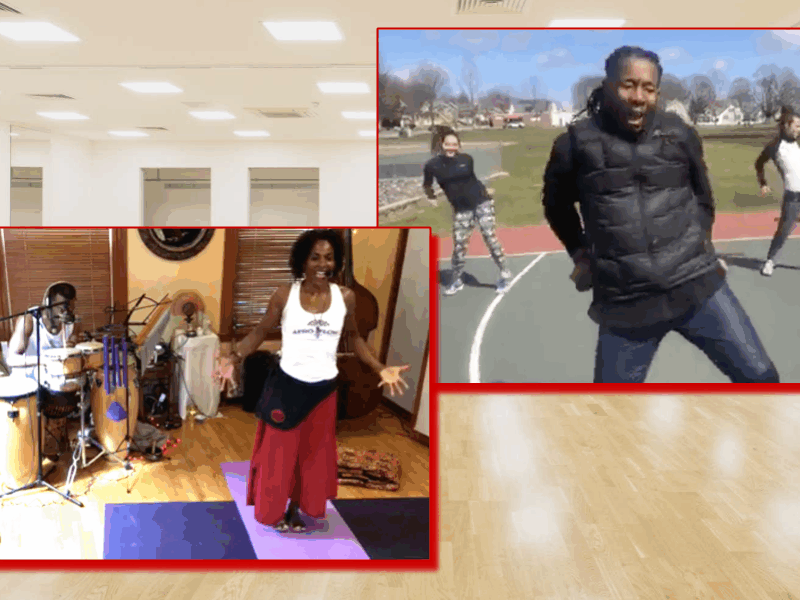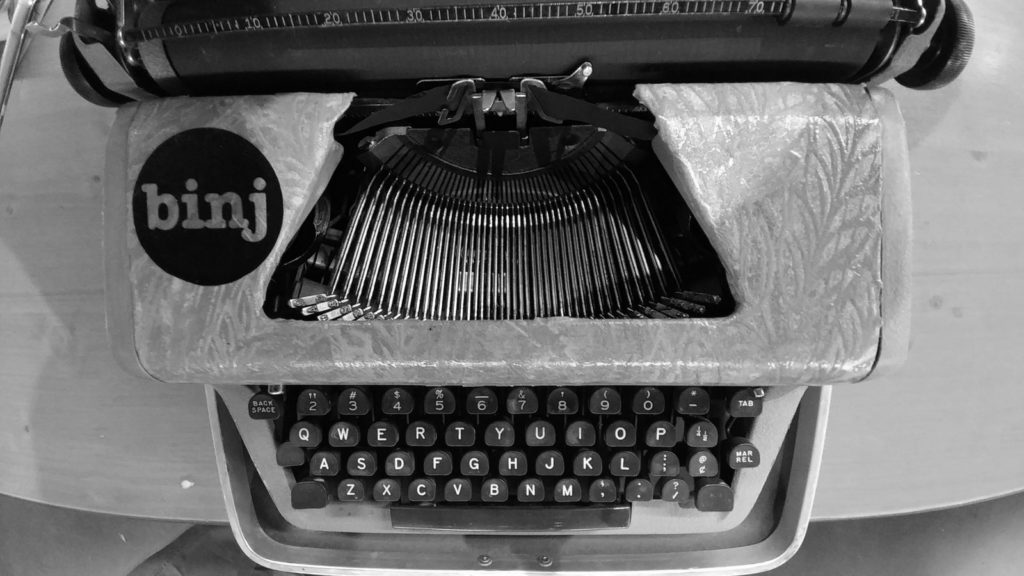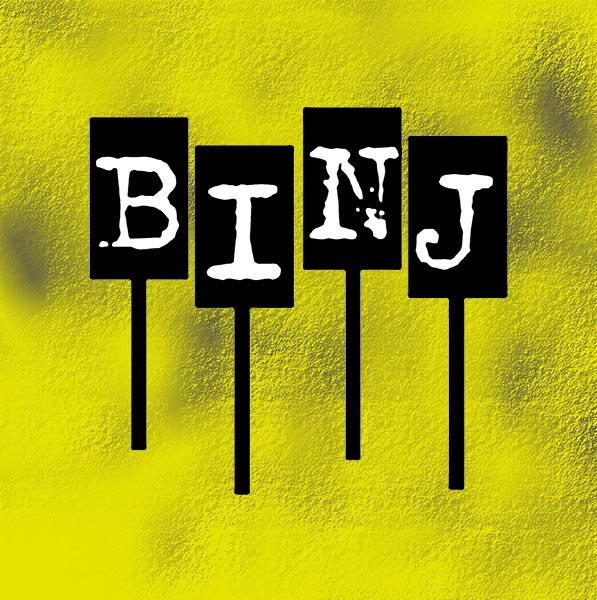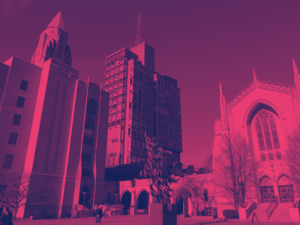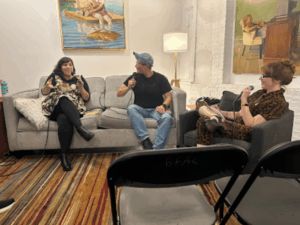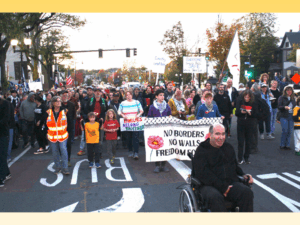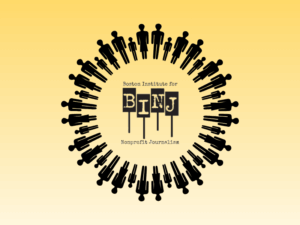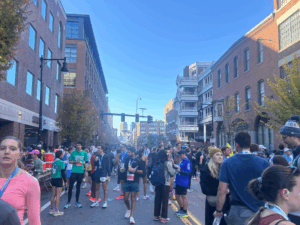“Just having something outside of news, some connection—we’ve found people are really thirsty for it.”
It’s 1:30 pm on Sunday afternoon and Leslie Salmon Jones is setting up to teach her Afro Flow Yoga class—a combination of Vinyasa yoga, dances of the African diaspora, and live music—in a makeshift studio at her house. She fiddles with Zoom on her computer, which she’ll use to cast the class, as well as Instagram and Facebook Live. Her partner, Jeff Jones, scurries around in the background, running sound checks, and setting up a mini stage where he’ll play various instruments—including a bass, drums, a tambourine, and more throughout the class.
Greater Boston’s under quarantine, so to speak, and the Afro Flow Yoga folks, along with many other dancers and artists, have moved their classes online. This new virtual reality is the result of social distancing initiated as a precaution to the COVID-19 crisis, which has cancelled face-to-face events for the foreseeable future. Still, an abundance of free and paid dance classes are popping up online that are both helping artists find stability in a precarious gig economy, and helping dancers and students find connection, community, and healthy ways to cope in the midst of a crisis.
While the Afro Flow crew usually attracts around 40-50 attendees at a regular class at the Dance Complex in Cambridge, after just one week of streaming, they have more than 7,000 views on Facebook alone from just one class. Salmon Jones says she’s had attendees from as close by as Northeastern University, to folks tuning in from Barbados, Costa Rica, and Delhi.
Leslie opens the class by dedicating her practice to essential workers—from health care professionals, to grocery store employees who are risking their lives on the front lines of the crisis in order to care for others. Later on, during the class, she cites a quote from her neighbor, with whom she had “socially distant” conversation earlier: “Instead of thinking of this [current situation] as social distancing, we can think of it just as physical distancing. We can still be social [here].”
Salmon Jones’s words undermine the heightened importance of virtual dance classes and arts experiences in times of crisis. Tina Caviccio, a Boston-based Latin dance instructor, also notes the collective benefit of engaging in online dance experience in the midst of coronavirus calamity. She recalls a recent virtual dance rehearsal she had with one of her squads: “The team was so happy to be back around each other, even if it was on a screen. Just seeing each other created this feeling like you are a part of something and working together towards this common goal. It makes you feel like you are not alone.”
Amber Jamanka, who takes hip-hop and house dance online, among others, notes the upside of participating in classes that are in real time: “There’s something nice about knowing you’re doing these classes live with other people, instead of just watching a recording. It allows you to feel that connection with other people in the group.”
Ashton Lites, a dancer and professor with experience in krumping, hip-hop, tap, house, and other styles, says virtual classes “definitely help with feeling a bit more connected right now.” Also known as Stackz, Lites has brought his Stiggity organization, which uses urban arts to teach life-building skills, online. “A lot of people are struggling, especially people that live alone. They are like, Man, I just need some human interaction, like a hug. In class, they’re excited to see and talk to people, relate and tell stories.”
Media as therapy
Many people are using online dance to destress, create structure, and provide a sense of familiarity and home in the face of uncertainty, fear, and collective grief brought on by coronaviru. Lites explains: “Given the current crisis situation, and because in America, people are dealing with a lot of mental health issues and depression as it is, it’s hard to keep your energy balanced. … I feel like people are going in two different directions. The first is that people are taking time to sit and be with themselves and go through all this. And two, there’s also a spike in depression and mental health issues in general, which I’ve seen people post on social media. Dance classes are definitely dope in the sense that they can offer aid to that. There is no way to get through social distancing without the arts or artists.”
Salmon Jones, who also teaches locally at Northeastern University, echoes Lite’s theory: “A lot of students are in fear because they are scared for their future. They’ve never seen anything like this before and they need to express themselves. We had one college student who broke down in class. We also teach elders [at a different location], and they are in fear for different reasons. It’s very easy for us all to get into this doomsday, apocalyptic mindset. We don’t know what the future will be but what we realize is that this mindset can affect the immune system. Just having something outside of news, some connection—we’ve found people are really thirsty for it.”
Despite the isolation, for some, this “new normal” has ironically fostered social connections and paved an opportunity for many to connect with new virtual communities. Raquel Cardoso, an artist and educator who recently relocated to her native, Lisbon, Portugal from Boston, was a regular at a Haitian folkloric class with Jean Appolon at the Dance Complex in Cambridge for years. She says the stay-at-home order in Portugal has pushed her to reconnect with the “JAE” (Jean Appolon Expressions) dance community she says was such an important part of her life in Boston.
“It’s been comforting to be able to take part in this community’s classes,” Cardoso says. “It’s been something I’ve been missing anyway [while living abroad]. Especially now, during a time of crisis, I can still be a part of this community that I’ve had in my life for so long, and that I just don’t have here in Lisbon. It’s interesting that it took the coronavirus to get everyone online, but for me, for someone who’s abroad, it’s been so needed to have that support.”
Virus as voice
Dancers and artists note that the explosion of virtual dance and arts experiences created during the crisis is not only helping people cope at an individual level, but also motivating artists and activists to come together and confront broader social issues connected to the crisis. Salmon Jones maintains that the virus has created a “huge time for collaborating” among artists, even in the midst of social distancing and virtual connections. In turn, these collaborations are pushing people to question the sustainability of our healthcare, food and economic systems, and to consider vulnerable populations, especially gig and part-time workers who are forced to put themselves at risk at places like grocery stores.
“A lot of our old systems have been so challenged by this coronavirus—patriarchy, colonialism, capitalism, and now we are facing all of this,” Salmon Jones says. “These systems are coming down. So now is a good time to envision something new. We’re all pregnant and set to birth something new—ways of being, habits and other ways to care for ourselves and our planet.”
Key Classes
Check out these virtual dance experiences with top notch local instructors:
- House dance with Sean Bjerk: Choreography, beginner and all level classes, on YouTube.
- Afro Flow Yoga: Sundays at 1:30pm on Zoom, Facebook, and Instagram Live. Donationtion-based with partial proceeds going to organizations including Doctors Without Borders.
- Haitain Folkloric Classes with Jean Appolon Expressions: Saturdays at 2:15 on Facebook Live, donation based.
- Hip Hop Fundamentals online series with Stackz.
- Tina Caviccio: Pop-up virtual Latin dance classes.

